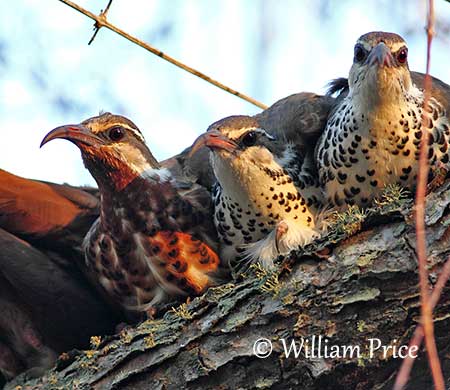
TO BE CONTINUED... Page 9 (First part)
Text by Nicole Bouglouan
Photographers:
Roger Ahlman
Pbase Galleries Peru and Ecuador
Didier Buysse
Vision d’Oiseaux
Alfredo Colón
Puerto Rico Wildlife
Maxime Dechelle
LEPAPARRAZO
Jean Michel Fenerole
Photos d’Oiseaux
Tom Grey
Tom Grey's Bird Pictures
Eduardo Andrés Jordan
MIS AVES – AVES DE ARGENTINA
Tom Merigan
Tom Merigan’s Photo Galleries
William Price
PBase-tereksandpiper & Flickr William Price
Dubi Shapiro
Dubi Shapiro Photo Galleries & Dubi Shapiro's Pictures on IBC
Alan & Ann Tate
AA Bird Photography
Callie de Wet
GALLERY
Nicole Bouglouan
Photographic ramble & My pictures on IBC
These images and the text are subject to copyright and cannot be used without express authorization from the owners. Legal issues
Sources :
HANDBOOK OF THE BIRDS OF THE WORLD Vol 2 by Josep del Hoyo-Andrew Elliot-Jordi Sargatal - Lynx Edicions - ISBN: 8487334156
L’ENCYCLOPEDIE MONDIALE DES OISEAUX - Dr Christopher M. Perrins - BORDAS - ISBN: 2040185607
Wikipedia, the free encyclopaedia
Bird nests: Variety is Key for the world’s avian Architects
Be on the lookout for bird nests
The design and function of birds' nests
The bird and its nest, where everything starts…
Page 8: Mesithornithidae, Turnicidae, Gruidae, Aramidae, Psophiidae, Rallidae, Heliornithidae, Rhynochetidae, Eurypygidae, Cariamidae and Otididae
At the beginning of the breeding season and following several courtship displays, the nest-site is selected by the pair, or one of the members of the pair, and the nest is built within this area. For numerous species, the nest is the place where displays and copulation occur. It plays a very important role during the nesting period. It is the cradle of the chicks, the place where the adults feed them prior to their first flight towards independence.
We can find several families of terrestrial birds nesting on or near the ground in this group.
The family Mesitornithidae is endemic to Madagascar. It is now included in the Order Mesitornithiformes
The mesites are ground-dwelling birds with elongated bodies and sometimes almost cylindrical look. They have small head and broad tail. The short, rounded wings and strong legs and feet indicate both rare flight and terrestrial habits. The stout bill is more or less decurved and of short to medium length, depending on the foraging behaviour of each species. They lack oil glands, but they possess powder-downs that help to insulate the bird.
They usually breed during the rainy season with the laying between October and April, with peak in November/January.
The three species nests almost at ground-level, between 60 cm and 3 metres above the ground, in bushes or shrubby-trees, in thin clumps of vegetation or in sloping trees. These locations can be reached without flying.
The nest of the Subdesert Mesite is a shallow platform of woven twigs with leaves and bark. It is placed in bushes or shrubby-trees, between 60 cm and 2 metres above the ground. The birds reach the nest by climbing up liana tangles.

The White-breasted Mesite nests in thin clumps of vegetation, 1-3 metres above the ground. The nest is a loose platform made with sticks and lined with some leaves and plant fibres.
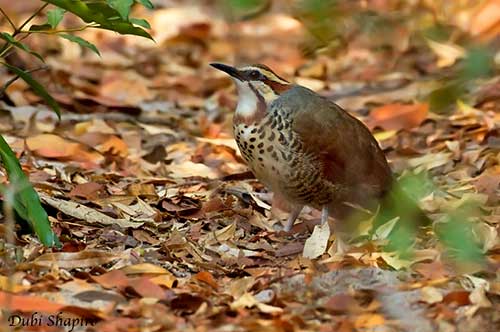
The nest of the Brown Mesite is a platform made with twigs and thin sticks, and lined with some leaves, grass and moss. It is placed in the fork of a sloping tree, 1-2 metres above the ground, allowing the bird to reach it without flying.

The family Mesitornithidae is the most threatened of all bird families in Madagascar. The three species are globally threatened and listed as Vulnerable. They are affected by habitat loss through degradation, fragmentation and destruction of forest. Hunting pressure and predation by wild birds, dogs and rodents also affect the mesites.
The buttonquails of family Turnicidae are now placed in the order Charadriiformes, after being allied with the true quails in the order Galliformes, and the rails and related bird species in the order Gruiformes.
These small birds of 12 to 23 centimetres in length have short, strong legs and toes well adapted for walking and running. They have brown, grey and rufous plumage with black mottling and vermiculations, and the females are larger and brighter-coloured than males.
They live in grassy or bushy habitats in the warmer parts of Africa, Eurasia and Australasia. They are secretive birds, and react to potential danger by squatting motionless, helped by their cryptic plumage coloration. They feed on seeds, invertebrates and plant matter.
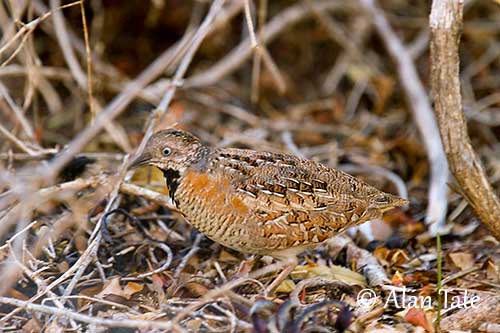
Both mates search for a nest-site, but the female selects the final site. The nest is a depression on the ground often within a tussock of grass and lined with grass stems, with sometimes a canopy formed by grasses and a side entrance with a short tunnel. In dense cover, a runway leading to the nest may be built. The territory is usually defended by the female.
The cranes of family Gruidae in the order Gruiformes are large terrestrial birds, often seen in wet areas. But their large wings allow them to fly easily. Most of these birds are migratory, and travel long distance to reach their wintering or breeding grounds. Some of them are able to fly above the high mountains of the Himalayas, others cross wide deserts.
The territories are established soon after the arrival on the breeding grounds. The cranes often return to the same nesting-site year after year. The size may vary according to the species and to the range. The pair becomes territorial and defends its area through unison calls, threat postures and attacks at intruders or rivals.
The cranes breed usually in densely vegetated wetlands above surrounding water, but some species nest in drier habitats. Both sexes take part in nest building.
The nest is on the ground and is a very simple structure, made primarily with reeds and sedges. In drier habitat, pebbles, gravels and small stones can be added to some vegetation.
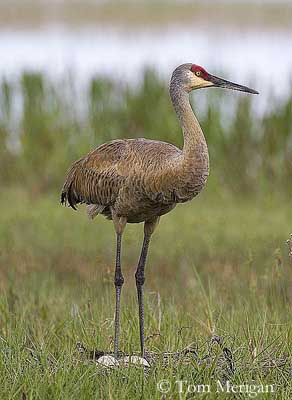
Adult at nest with two eggs
Two eggs are laid directly on the ground. Both parents share the incubation during about one month, between 28 and 36 days according to the species.
The adults care for the young through the entire fledging period which can vary according each species and the juveniles remain within the family group until the following breeding season.
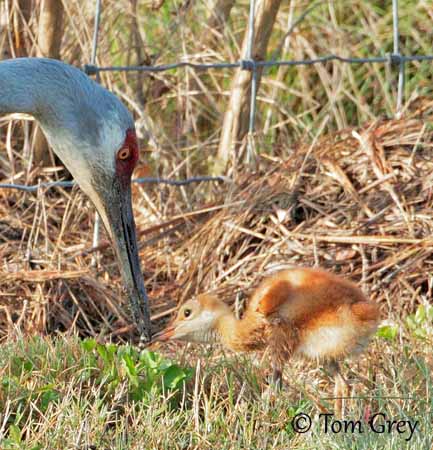
Adult feeding a chick
The Limpkin is the sole member of the family Aramidae and placed in the order Gruiformes. It is a large brown rail-like or ibis-like wading species. It has long bill, neck and legs.
It lives in marshy wooded areas. It is resident in open freshwater marshes, swamp forests bordering slow-moving rivers, lake or pond shores, and mangroves. It is found in Florida, West Indies and from Southern Mexico to Argentina.
The nest site is usually selected by the male. The nest may be built in a wide variety of sites such as a few centimetres above water on floating vegetation, among tall marsh grasses, in shrubs or stumps covered with tangled vine or in isolated pond bush in the Everglades…
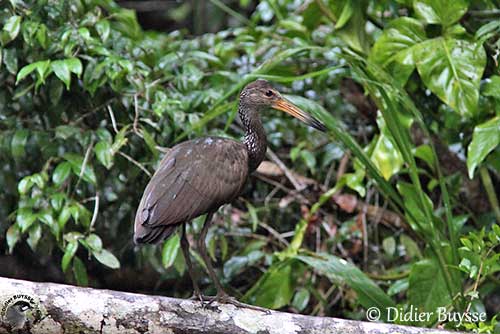
The Limpkin’s nest is a platform made with woven reeds and twigs. This platform is used to elevate nesting materials above water. Actually, it is made with material found in the habitat, and these materials vary according to the environment. The male starts to build the nest, but the female usually contributes to final nest-building and to other nesting duties. The nest is well hidden, but with clear view for sitting birds.
The trumpeters of the family Psophiidae are about the size of a domestic chicken. They have terrestrial habits and live in dense tropical forests in N/NE South America. They are mainly frugivorous, but they also consume invertebrates and small vertebrates.
These birds have a rare breeding system and practise co-operative polyandry. This system is known for only 8 bird species throughout the world. Trumpeters live in well-organized hierarchical groups including usually a dominant female and three dominant males, and their young.
The breeding behaviour of the Green-winged Trumpeter or Dark-winged Trumpeter is poorly known, but the two other species have been studied.
The Grey-winged Trumpeter may nest in small colonies. The nest is placed in tree hole, about 4 to 13 metres above the ground. Some plant materials can be added, such as twigs and leaves. But the nest can also be a simple scrape on the ground. They are territorial and defend strongly their territories.
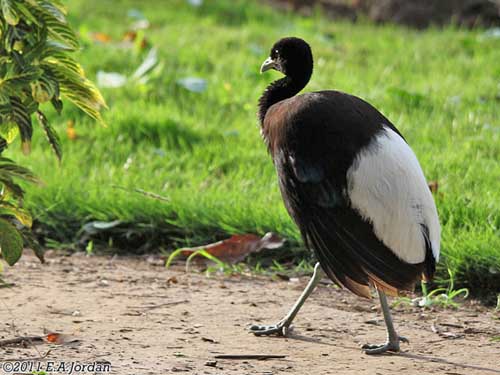
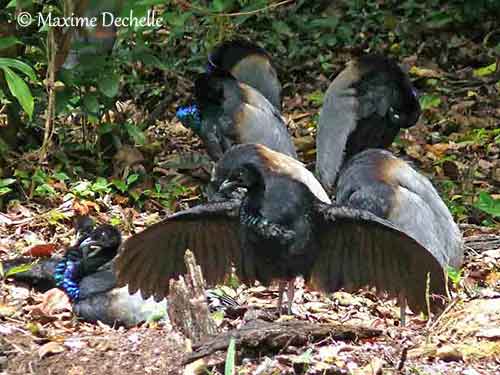
Group
The Pale-winged Trumpeter forms co-operative breeding groups. Only some individuals of the group breed, but all members take part in nesting duties. Only the dominant female lays eggs. She copulates with the three highest ranking males of the group, Alpha, Beta and Gamma. This mating system is known as co-operative polyandry, in which several males copulate with only one dominant female.
During the nest-site selection, the male or the female, or both, enter the cavity and remain inside during several seconds or minutes. They may toss out debris and leaves from the floor of the hole, and even sit down as during the incubation.
Several potential sites (10-12) are visited by the pair, but they select a cavity about one week before the laying. Both mates clean the hole, only leaving a thin lining of decayed wood. Such cavity is at about 10-12 metres above the ground. Once the nesting cavity is chosen and ready, the female lays 2-4 white eggs.
The Rallidae, order Gruiformes, are terrestrial, marsh and aquatic birds. They frequent watersides of freshwater marshes and lakes.
These birds are often seen walking on exposed muddy areas, or clambering among emergent vegetation. However, coots and moorhens usually spend most of the day swimming in open water.
The behaviour of these birds is poorly studied, but usually, the Rallidae are solitary or in pairs, in family groups or in small flocks. The coots are more gregarious and may be seen in great numbers in the same water area.
Most species nest solitary and well separated, except when the nesting habitat is scarce. In this type of restricted nesting habitat, they may nest in loose colonies.
The nest, often chosen by the male but sometimes by both mates, is usually hidden among the dense vegetation. It is built among emergent vegetation, in reeds or grass. The surrounding and overhanging vegetation is pulled down or woven as a “roof” for better concealment. The nests situated in wetlands have pathways or ramp up to the cup.
Some rails build the nest on floating vegetation, and the structure is attached to the aquatic plants.
Gallinules and moorhens often build the nest at water level or on water, and they are often destroyed with flooding.
The Giant Coot builds a large nest platform, a bulky, non-floating structure made with aquatic vegetation and placed in open water, at variable distance from the shore. Such nest is very conspicuous and may reach three metres and more in diameter. The height above the water is about 20-25 centimetres. The deep cup prevents observation of eggs and chicks.

The nest of the Common Gallinule is a platform built by both adults. It is made with twigs and aquatic vegetation, or can be sometimes a wide, shallow cup with a ramp leading down to the water, made with similar materials. They often build a second nest in the vicinity for resting, sleeping or brooding. The nest-site is situated in marshes over shallow water, but also on the ground or in dense vegetation near water. In open water, it is anchored to the vegetation.
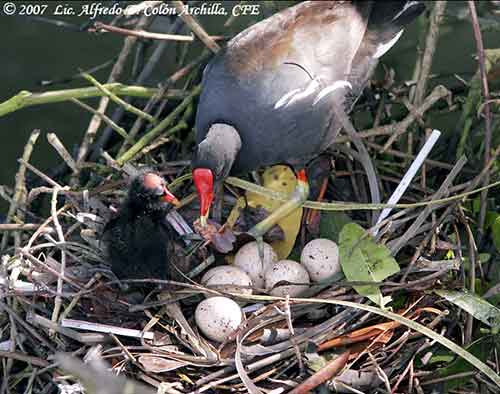
The Common Coot usually nests in emergent vegetation and in shallow water, and sometimes in open, occasionally on floating vegetation. The nest rests on the bottom or in trampled base of plants. The coot can also use artificial platforms or tree stumps, or islands. The nest is bulky, made with dead and green stems, leaves and twigs, bark, roots and reeds. Usually, the nest is build up if the water level rises. Both sexes take part in the construction of the nest, but the brood platform for the family is built by the male.

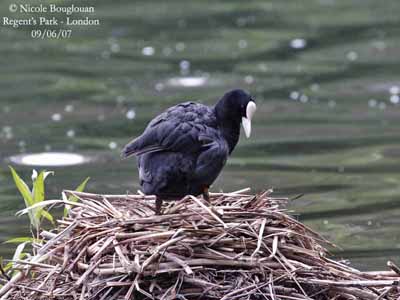
The nest of the Common Moorhen is a wide shallow cup made with dead vegetation (stems of cattails), well rimmed and lined with grass and leaves. The nest is located in shallow water, but anchored with stems to the emergent vegetation.
Sometimes, the nest may be located on the ground, in a low shrub, or on floating vegetation.
This species often breeds in urban waters, and the nest is usually lined with paper, string, plastic and all debris found in the vicinity.
Both adults build the nest. A sloping runway allows reaching or leaving the nest. They may sometimes nest in small colonies.
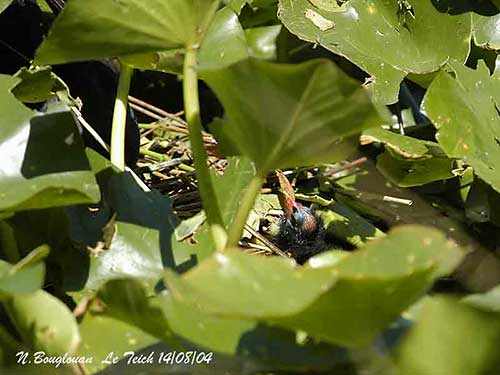
Chick at nest
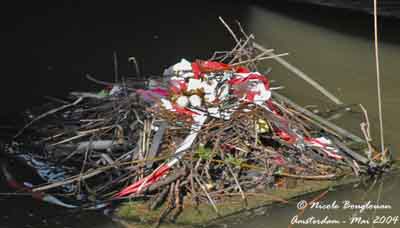
Urban nest
The American Coot nests in freshwater lakes, ponds, rivers or marshes. Both adults select the nest site, over water, in tall vegetation. The nest is built within vegetation, hidden on the ground near water, at water’s edge, or floating on the water. All nests have a ramp that leads into the water, so the young have easier access when coming and going from the nest which is cup-shaped. It is an aggregation of dead plant stems, lined with fine grass on a platform of aquatic vegetation. This platform is anchored to living plants.
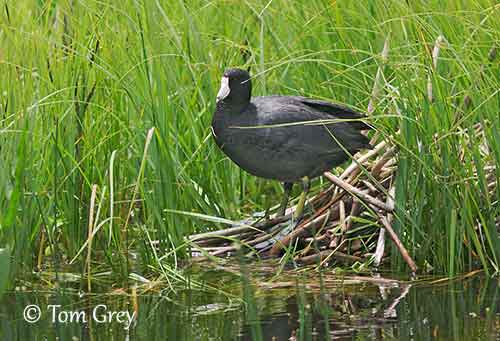
The nests of the rails are more concealed among the vegetation and often difficult to find.
The Water Rail nests in reedbeds. The nest is a bulky cup made with dead leaves and plants stems. It is often concealed in thick vegetation on the ground near water, or on water, rarely in open area. It may be built up to avoid flooded water. Both mates build the nest.
Later, the chicks follow an adult that led them to the foraging areas at the edge of the reedbed.
Depending on the location of the nest-site, numerous nests are vulnerable to changes of water levels, and flooding often destroys both nests and eggs.

Followed by its chick
The family Heliornithidae includes three species of three different genera: Podica (Africa), Heliopais (Asia) and Heliornis (America).
They share several features clearly related to their life. They have a long neck, slender body, long broad tail, sharp-pointed bill, lobed feet and sharp claws. The lobed (not webbed) feet allow the birds to propel themselves through the water, but they are also able to run on the ground and clamber into trees.
They frequent a wide variety of habitats with primarily water and vegetal cover. They can be found from sea-level up to 2,000 metres of elevation. They are usually seen singly, and sometimes in pairs with or without juveniles. They are not gregarious. They feed on aquatic insects and their larvae, small snails, worms and terrestrial insects and spiders. They catch the prey on the water surface while swimming or on the ground.
These birds nest usually over water, in a fairly untidy bowl-shaped structure made with sticks, twigs and reeds and lined with dead leaves. This nest is placed among thick overhanging vegetation such as masses of tangled dead vegetation caught in low branches or fallen trees. Male and female share more or less the nesting duties.
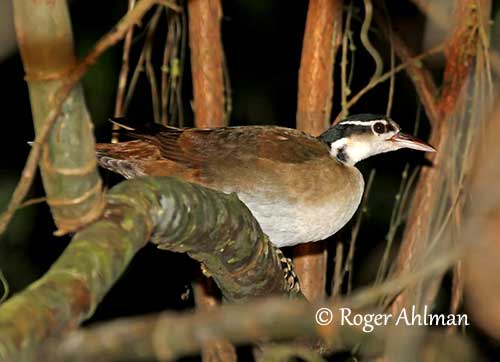
The Sungrebe is able to transport the chicks in flight. From an observation in Mexico by Alvarez del Toro, the male has a shallow pocket under each wings in which the young are transported. The pocket is formed by a pleat of skin, and there are some feathers just below, on the body sides. The heads of the chicks should be seen from below when the adult is flying. However, it may also carry its young on the back while swimming.
This is a unique adaptation among birds, and it raises numerous questions. Neither the African Finfoot nor the Asian Finfoot has such morphological feature.
The Kagu is the surviving member of the monotypic family Rhynochetidae, order Eurypygiformes.
Initially placed in Ardeidae family, the Kagu shows almost similar plumage. It also performs similar behaviour while feeding in shallow water, motionless, standing upright on one leg.
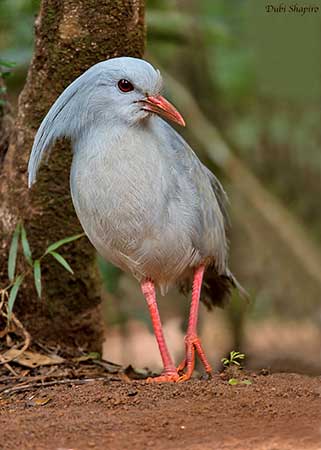
Endemic species to New Caledonia, the Kagu is a flightless bird, but it is able to use its wings, in order to assist some movements such as to climb into branches, or to glide in the air during descents. It lives in dense mountain forests, but now, it has restricted range, and lives under human protection. It feeds by probing with its bill into various kinds of soils and in leaf litter. It also catches preys in fresh shallow water at pool’s edges.
They are monogamous and mate for life. The nest-site is not especially concealed. The nest is often built against vegetation, tree trunk or old log. At higher altitude, it is often sheltered amongst rocks. This is a simple construction made with leaves, taken around the nest-site.
The Sunbittern is the sole member of the family Eurypygidae in the order Eurypygiformes. It is an amazing bird, mid-rail mid-heron, which performs spectacular displays.
It lives in the tropical regions of the Americas, from Guatemala to the Pantanal of southern Brazil and Paraguay, where it frequents the shores of shady streams and small wooded pools. It is also found in dense second growth thickets, near water. It can be seen from sea-level up to 1800 metres of elevation.
This species feeds mainly in shallow water, searching for invertebrates and vertebrates, insects, molluscs, crustaceans, but also fish, amphibians and lizards.
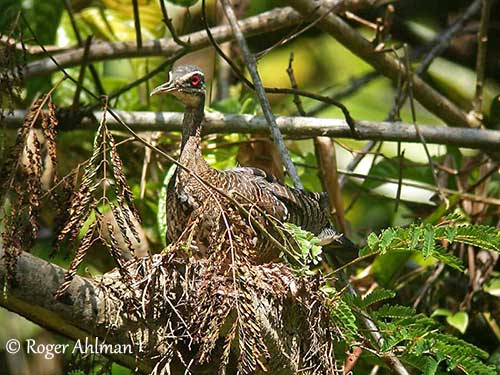
The Sunbittern performs spectacular displays, with help of the wonderful pattern of both wings and tail.
The nest is placed in trees, close to water. It is built on small branches under the dense canopy. The foundations are made with long grass fibres (20 to 25 cm), in oval shape, and anchored to the support with mud. The bird uses the leaves of the tree which shelters its nest. The cup is lined, or not, with leaves and mud.
The Seriema family of South America includes only two species. These large ground-dwelling birds have very long, slender legs adapted to their life. If disturbed, they run quickly and take flight only occasionally, in order to escape a danger.
They live in a variety of semi-open, fairly dry areas, including some of the drier landscapes (thorny scrub and woodland areas) of the South American continent. They feed on arthropods of various species, and usually large insects.
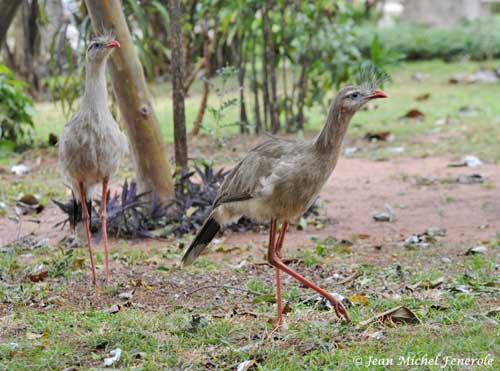
The seriemas are solitary nesters and monogamous, with nests scattered over a wide area. They nest in trees, about 1-5 metres above the ground, sometimes higher. The nest is built by both sexes on branches of small trees. This is a round structure made with sticks and twigs, and lined with leaves and mud or cattle dung. The birds reach the nest on foot with a series of jumps, using an access such as a sloping tree or jumping from branch to branch.
The Old World family Otididae belongs to the Order Otidiformes and includes highly terrestrial birds, often seen walking slowly or even staying motionless among the vegetation of plains and steppes. But if they do not fly very often, when they do take wing, they are able to sustain strong flight.
Bustards can be very large, but there are some smaller species too.
These birds are well known for their elaborated courtship displays, with spectacular transformation of the appearance, jumps, foot-stamping and dramatic leaps into the air in order to attract the females.

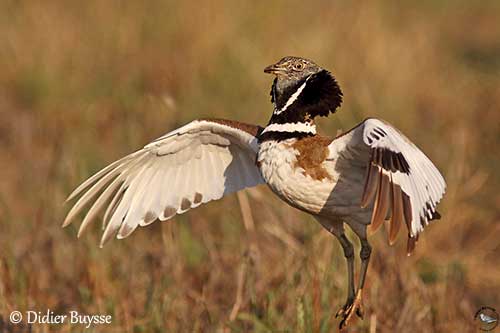
They are mainly insectivorous, the plant matter being only supplementary food. They can take green shoots, flower heads and fresh leaves in the European steppes. They dig up roots and bulbs, and feed seasonally on fruits and berries.
They frequent mainly tropical grassy open plains, usually below 2000 metres of elevation in seasonally dry areas. Other types of habitat have been colonised, such as near-desert and salt-steppes, but also dense bushland and thorny countries.
The nesting sites are often in the same areas, but more concealed in vegetation. As they nest on the ground, bustards are vulnerable to predation by large eagles and falcons, but also by snakes or mammals. The incubating females are well camouflaged thanks to the cryptic plumage, but in addition, they adopt a typical posture by pressing close to the ground in snake-like fashion and remain motionless. The chicks do the same, and respond to her different vocalizations, including those asking silence.
The nest in on the bare ground, or may be scraped clear of vegetation, sometimes slightly moulded and occasionally rimmed with bits of grass pulled down. It is usually near bushes, clumps of tall grasses or other weak cover, in order to avoid sitting in a complete open area, even if some nests have been found in open country.
The bustards are found exclusively in the Old World, from Eurasia to Australia. We can found the greatest diversity in Africa.